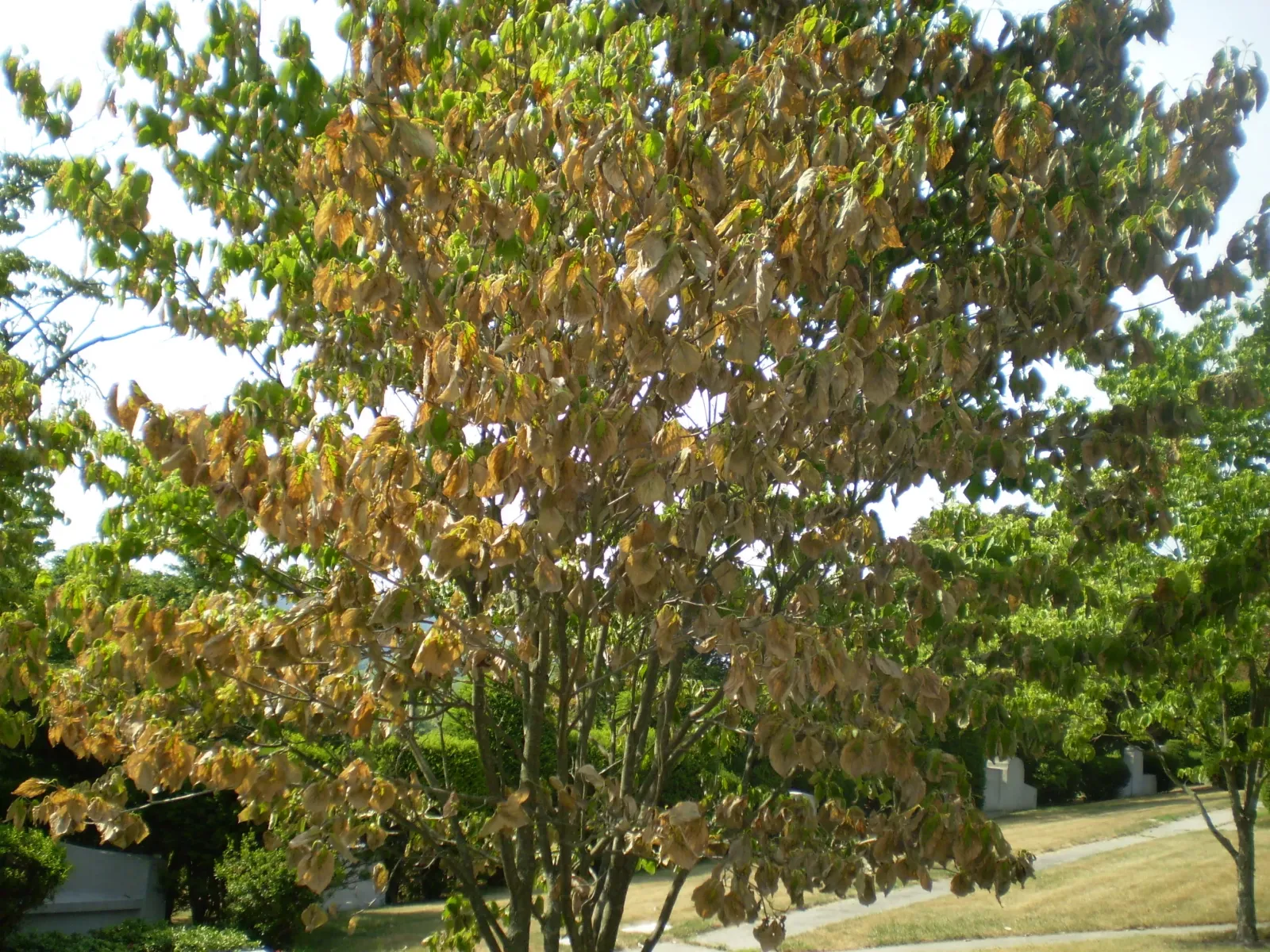TREE & SHRUB INSECT AND DISEASE IDENTIFICATION
Many species of insects or mites attack Georgia landscape plants. Homeowners have difficulty controlling these pests because they often are either not aware of the problem until both the infestation and the damage are extensive or they may apply insecticides improperly or at the wrong time.
Chewing Pests
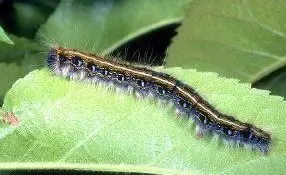
Tent Caterpillars
Tent caterpillars are attractively colored larvae that reach about 1 1/2 inches in length. They have a few long hairs on their bodies, mostly along the sides. They are commonly seen in the early spring closely associated with the webs or “tents” they construct in the crotch of small limbs on their host plant. This tent serves as a refuge for the larvae at night and during rainy weather. They have only one generation per year.
Fall Webworms
Webworm larvae are about 1 inch long when full grown and are pale yellow or green in color. A broad, dusky stripe runs down their backs, bordered on each side by a yellow stripe. They are covered with tufts of long whitish hairs. These larvae can be found inside unsightly webs at the ends of branches on host plants. Georgia has three to four generations of webworms per year.
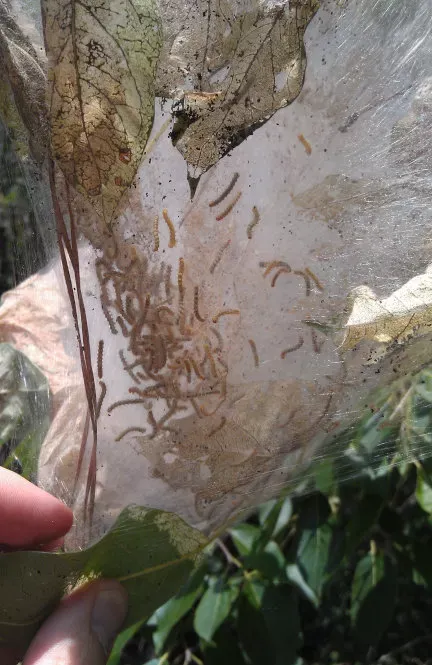
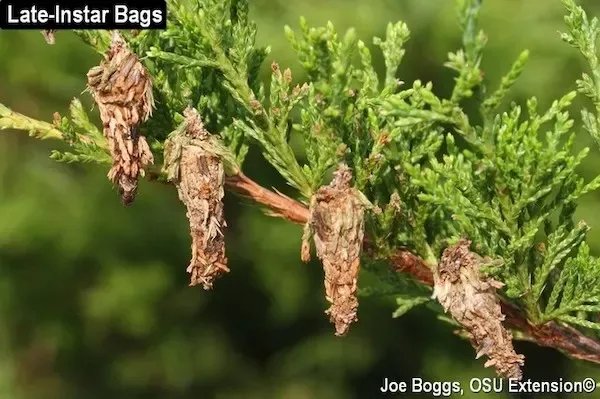
Bag Worms
Bagworms construct and live inside a 1- to 2-inch long tough, tear-shaped portable silken case. These bags are the insects most easily seen and identifiable feature. Outside, the silken texture of the bag is somewhat concealed with layers of leaf, twig and bark fragments. The bag has an opening at the larger end that allows the worm to partially crawl out to make repairs to its bag and eat.
Beetles
Several beetles, such as the elm leaf beetle, imported willow leaf beetle, flea beetle and Japanese beetle, attack trees and shrubs and cause feeding damage. Damage first appears when the green parts of leaves are removed, leaving just the veins of the leaf tissue remaining. As damage accumulates, dry skeletonized leaves become obvious. Leaves take on a rusty, reddish-brown tint.
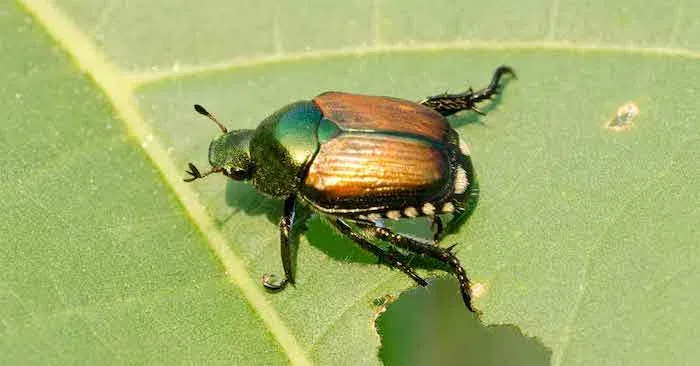
Sucking Pests
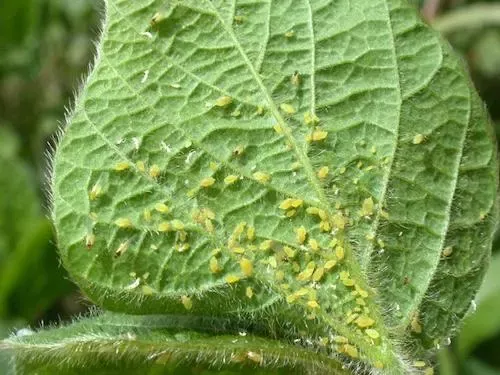
Aphids
Aphids are small (about 1/4 inch in length), soft-bodied insects that vary in color from green to yellow to black. Some species are winged during certain times of the year. Generally, aphids can be recognized by their cornicles, a pair of tube-like structures projecting from the rear of their bodies. Aphids secrete a honeydew substance that encourages the growth of black sooty mold on plant material. They are frequently found clustered together in large numbers on the backs of leaves or on the stems of new growth.
Scale insects & mealybugs
Scale insects are very small, soft-bodied pests that secrete a protective covering over their bodies. These coverings vary in color from white to red to black. Some are flattened while others are more turtle-shaped. This covering protects the scale and makes control difficult. Scale insects are most easily controlled when insecticide applications are timed for the first instars or “crawler” stage of the scale. Mealybugs are similar to scale insects; however, they secrete a white waxy material over their bodies. Mealybugs also move about on the host plant to feed. Mealybugs are most susceptible to insecticide applications when they are young and have not formed a thick covering over their bodies.

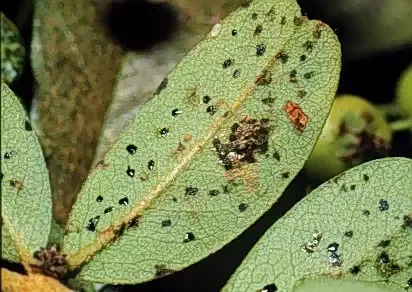
Lace bugs
Lace bugs get their name from the appearance of the area behind their head and wing covers. The area forms a lacelike covering over the body of the insect. They are 1/8 to 1/4 inch in length and are partially transparent. Lace bug damage appears on the upper leaf surface as white to yellow chlorotic spots. The lower leaf surfaces will be cluttered with black spots and the old cast skins of immature lace bugs. Initiating control in the spring between March and May will reduce problems later in the season.
Spider Mites
Spider mites are most often found on the backs of leaves. They are so small they can barely be seen with the unaided eye. The adults are oval-shaped and have eight legs and no antennae or wings. A sign of their presence is a stippling appearance on the upper sides of leaves on broadleaf plants and a browning of needles on conifers. Sometimes webbing is present.

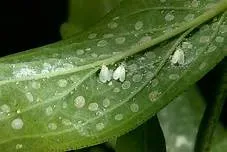
Whiteflies
Whitefly adults resemble small gnats. They range in size from 1/10 to 1/16 inch and have four broad, delicate, milk-white wings. The immature whiteflies are attached to the underside of leaves and resemble scale insects. They are oval, flattened and yellow to almost transparent. Whiteflies secrete a honeydew substance that encourages the growth of black sooty mold on plant material. Whiteflies often occur in tremendous numbers and when a heavily infested plant is disturbed, the air is filled instantly with a white cloud of these insects.
Boring Pests
Asian Ambrosia Beetle
Most of these pest’s attack trees or shrubs that are already weakened or injured by transplant shock, drought, flooding, soil fills, mechanical damage or disease. The larvae are 1/4 inch to 2 inches in length, yellowish-white and legless. They burrow or tunnel into the bark and sapwood of infested trees. They introduce and cultivate ambrosia fungus, which they feed on. Sawdust and insect wastes are pushed out of the boring hole and look like toothpicks.

Diseases
Just because a plant is susceptible to a disease does not necessarily mean it will become diseased. In order for disease to occur on a particular plant, three important factors must be present at the same time: 1) a plant must be susceptible to the disease, 2) the disease-causing agent (pathogen) must be present and able to infect the plant, and 3) the environment must be favorable for disease development. If one of these components is missing from the “disease triangle,” then disease will not occur. Several key practices can help minimize potential disease problems on landscape plants.
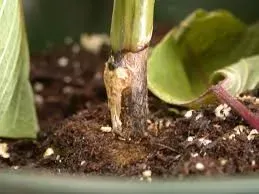
Root Rots, Crown Rots, & Damping-off
Root rot diseases are by far the most damaging diseases in Georgia’s landscapes. They occur in wet soils with limited soil drainage (porosity) or in areas that are over-watered or remain wet due to location of gutters and downspouts, air conditioning units and slopes, etc. All landscape plants (trees, shrubs and flowers) are susceptible to root rot. The most common pathogens causing root rot diseases are the soil-borne fungi Pythium, Phytophthora and Rhizoctonia. Several other fungi also cause root and crown rots, but they are more common on some plants than others. For example, Southern blight caused by Sclerotium rolfsii is more common on herbaceous perennials and vegetable transplants. Black root rot caused by Thielaviopsis basicola is more common on bedding plants such as pansy, petunia and annual vinca, as well as Japanese holly (Ilex crenata) and anise (Illicium spp.). Plants attacked by soil-borne pathogens may be stunted, develop lesions at the soil line, or wilt and collapse. When larger plants become infected with root rot pathogens, aboveground symptoms include poor growth, off-color foliage, yellowing and dropping of lower leaves, wilting and death. Infected roots are usually brown, soft and decayed. Some root rot pathogens invade the lower stem as well, causing tan, dry cankers or a soft, dark-brown, watery stem rot.
Powdery Mildew
Powdery mildew is characterized by the presence of whitish fungal growth on the surfaces of leaves, stems and flowers. Infection of young, expanding leaves or shoots can result in severe distortion. There are many different fungi in the powdery mildew group; some are quite host-specific while others can infect a wide range of plants. The fungi obtain nutrients from host plants by penetrating the outermost layer of plant cells. Powdery mildew spores are easily dispersed by air currents to surrounding plants, infecting plants of the same species. Unlike most fungal diseases, leaf wetness is not required for powdery mildew infection.
Disease development is favored by high humidity caused by dry, sunny days followed by cool, moist nights. Powdery mildew is common on woody plants including roses, crape myrtles, euonymus, dogwood and oak, as well as herbaceous plants such as verbena, phlox, monarda and gerbera daisy.
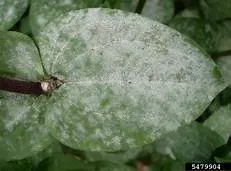
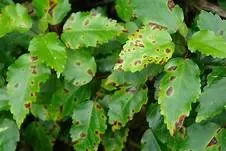
Fungal Leaf Spots
Fungal leaf spots are very common on landscape plants. However, very few cause serious damage to the affected plants. The leaf spot disease on red-tip Photinia, caused by the fungus Entomosporium, is an exception. This disease has virtually eliminated red-tips from Georgia landscapes. Fungal leaf spot symptoms range from tiny discolored specks to larger blotches. The lesions often have tan to gray centers with darker brown, red or purple margins depending on the host plant and pathogen involved. Most of these diseases affect only one or a few plant species. Fungal leaf spot pathogens survive on infected plant debris and are spread by spores carried in air currents or splashing water. Prolonged leaf wetness favors fungal leaf spot disease development.
Leaf Rusts
Leaf rust diseases are common on roses, snapdragons, hollyhocks, crabapple and, most recently, daylilies. The most diagnostic sign of the disease are the raised pustules that rupture to release powdery, orange to rust-colored spores on the underside of the affected leaf. Light colored to yellow spots can be seen on the upper leaf surface directly opposite the rust pustules.
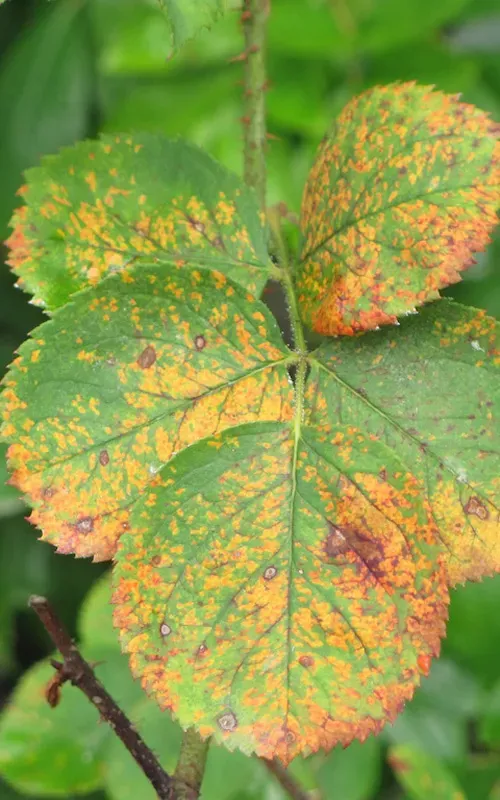
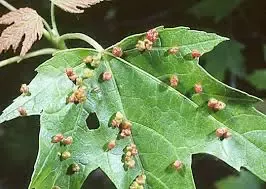
Flower & Leaf Galls
Leaf and flower galls, caused by the fungus Exobasidium spp., are common on azalea, rhododendron, mountain laurel (Kalmia) and camellia in the spring during wet, humid, cool weather. Infection only occurs at leaf or flower bud break if favorable environmental conditions exist. Leaf and flower tissue swells and becomes fleshy and off-color. Initially galls may be light green to pinkish. As they age, the galls turn white. On camellia, only the backside of the affected leaves turn white. Eventually the galls blacken and turn hard. Spores for the following year’s infection are released when galls are white. The disease does not cause significant damage to affected plants.
Botrytis Blight
Botrytis blight is an ever-present threat to ornamental plants in the landscape and greenhouse. The fungus causes a range of symptoms, including spots and blights on leaves and flowers, stem cankers, crown rot, wilting and damping-off. Botrytis infections also may cause discoloration and death of flower buds and premature loss of flowers. The fungus is spread by the movement of spores in air currents, in splashing water and on insects. The fungus commonly invades wounded or senescent tissue, such as fallen flower petals or other fresh plant residues. It can also invade healthy tissue in contact with infected residues. Masses of fuzzy, grayish-brown spores on thin black stalks develop on infected plant tissues under cool, moist, humid, cloudy conditions. The presence of these spores is diagnostic for confirming Botrytis infections.
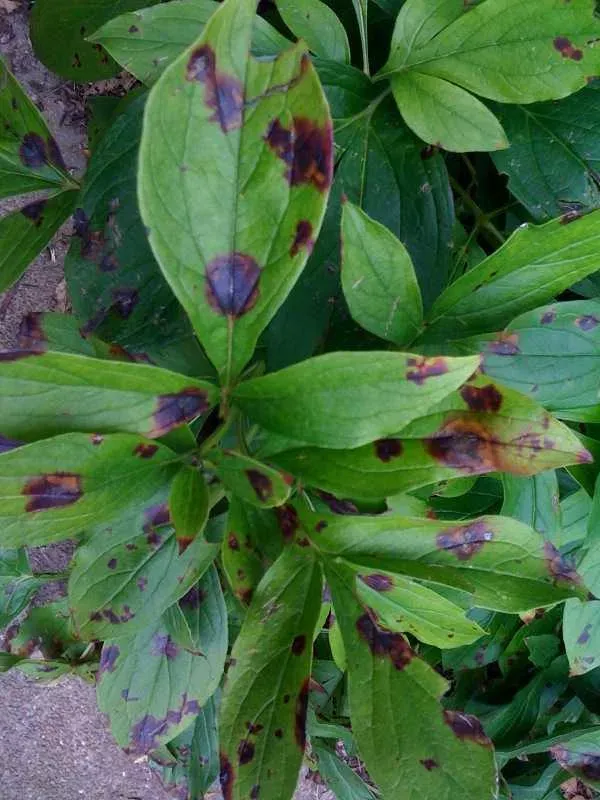
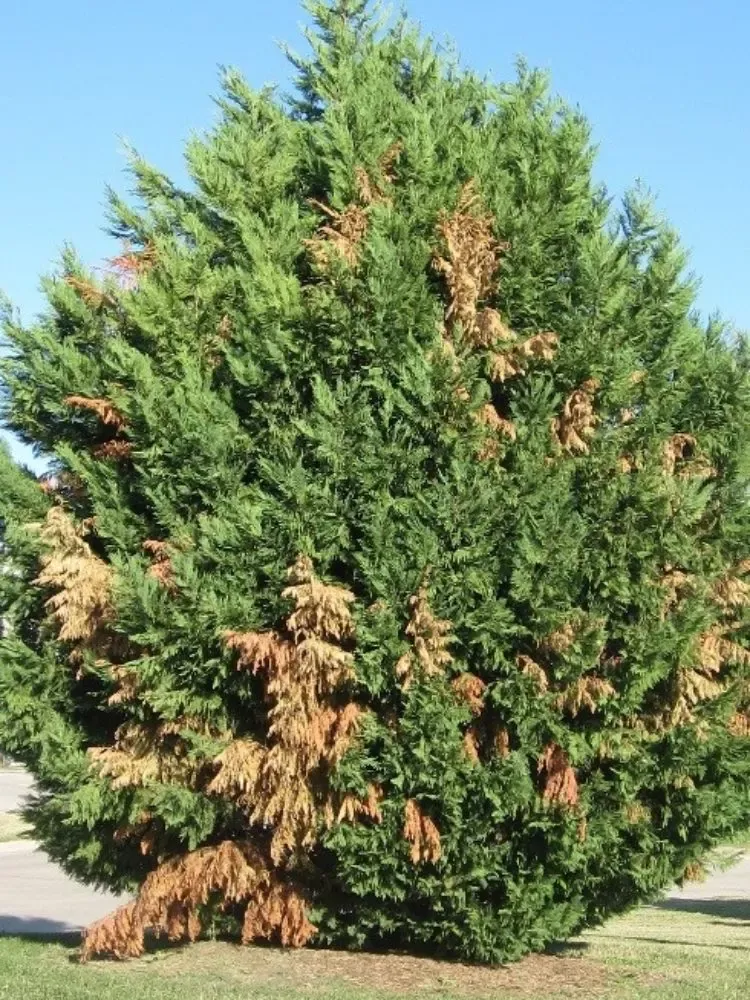
Seiridium Canker
This disease is particularly prevalent on drought stressed Leyland Cypress trees during hot weather. The disease is caused by the fungus Seiridium unicorne. Yellowing and browning of old foliage precedes fading and death of twigs and branches. Sunken, long cankers with a reddish tinge develop at wounds on bark, bark is darkened and resin exudes from margins of cankers. Infection can occur on any part of the plant and stage of the tree. Infected trees look thinly branched.
Bacterial Diseases
Bacterial pathogens cause leaf spots and stem rots on a variety of ornamental plants. Leaf spots are initially water-soaked or greasy in appearance, often angular and concentrated along leaf veins or margins. In some cases, the leaf tissue surrounding the necrotic spots may be yellow. Bacterial pathogens require films of water to enter plant tissues. Cool, wet conditions favor leaf spots caused by Pseudomonas species. Bacterial soft rots of stems are usually associated with wounds from handling or insect feeding. Fungus gnat larvae can spread soft rot bacteria. Bacterial diseases of ornamental plants can cause wilt and death of plants. Any plant suspected of having a bacterial disease should be sent to a diagnostic laboratory for confirmation of the disease.
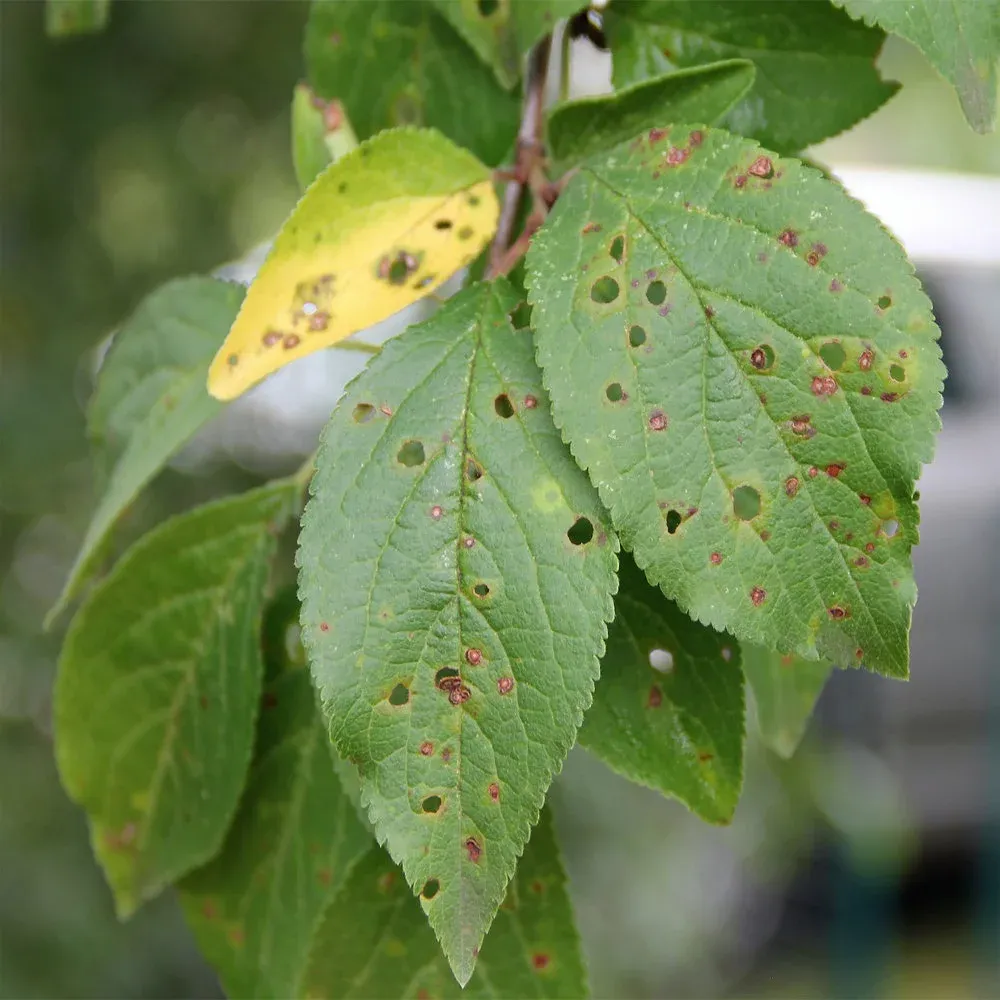

Fire Blight
Fireblight is a destructive, highly infectious and widespread disease caused by the bacterium Erwinia amylovora. Fireblight affects plants in the Rosaceae family such as pear, crabapple, cotonoaster, photinia, pyracantha, quince, etc. Young twigs and branches die from the terminal end and appear burned or deep rust colored. Branches may bend resembling a shepherd’s crook. Dead leaves and fruit generally remain on the branch. Infection occurs during blooming and is favored by wet, warmer conditions. The disease is most apparent in April-June.
Drought Stress in trees
After years of drought, many trees show symptoms of drought stress. Some plants are more affected by drought than others, such as bald-cypress, beech, dogwood, and magnolia. Many native species are particularly adapted to drought conditions. Native trees that tolerate drought include hackberry, hickory, hawthorns and oak. Trees can show drought stress in a variety of ways. Leaves may wilt, turn yellow, show early fall color, turn brown at the tips, curl, or show all of these symptoms. Green leaves, stems, roots and fruits may contract. Shrinking can cause radial cracks in the tree trunks. The leaves of some trees such as hickory will usually turn yellow and drop easily. River birch, dogwood and red maple may show early fall color. Pine trees seldom show drought stress unless the drought is prolonged. Pines needles will bend or droop at the base of the needle. Needles then either turn brown or remain green and are permanently bent. Second year needles will often turn yellow and begin to drop from the tree prematurely.
